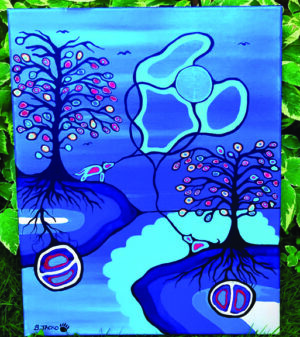Miywasin Moment: From cottonwood to cedar, trees are good medicine
By JoLynn Parenteau on May 4, 2022.
"All Land Is Sacred", 16x20" Acrylic on canvas by Ojibway artist Brandon Jacko, Wikwemkoong Unceded Territory, Manitoulin Island.--PHOTO PRINTED WITH PERMISSION, Instagram @bjackoart
Every year on the last Friday in April, trees are planted worldwide in honour of Arbor Day. First observed in Nebraska in 1872, last week the tree planter’s holiday celebrated its 150th anniversary.
Across time immemorial, Turtle Island’s (Native North America) original inhabitants understood, respected and nurtured trees for their life-sustaining benefits.
For Indigenous peoples, trees provided raw materials to build longhouses, wigwams and tipi poles for traditional shelters.
Seasonal harvests of fruit and berries were eaten fresh or dried to last over the cold months, while walnuts, pecans, and other nuts provided nutrition year-round. Acorns from the hardy oak tree were ground into flour, a valuable dietary staple.
Many trees provide edible bark used in traditional medicines, such as the balsam fir, birch, slippery elm, spruce and tamarack. Willow bark tea is famously medicinal for relief from pain and fever. Soaked and dried birch bark made a sturdy cast for broken bones.
The cottonwood tree which grows in abundance in Medicine Hat had many uses that varied by region. Its trunk was carved into dugout canoes. Arizona’s Hopi, Navajo and Pueblo tribes used its roots for carving kachina dolls, masks and ceremonial objects. Many Plains peoples revered the cottonwood as a medicine tree. Its bark and leaves were used to treat wounds and swelling, and the buds have anti-fungal, anti-inflammatory and anti-microbial properties, as well as provide a yellow dye for clothing and secrete a sticky resin used for glue.
One of the Four Sacred Medicines, the cedar tree is used in ceremony and everyday life. Cedar can be burned for smudging, a purification ritual for our spirits, bodies and homes.
It is said cedar sits in the northern doorway, and Elders say the spirits enjoy the aroma produced when sacred medicines are lit.
Cedar baths are said to be healing. When an offering of cedar and tobacco is made to the fire, it crackles, awakening the attention of the spirits.
Cedar boughs provide protection over the floor of a sweat lodge, and are laid on the ground encircling the lodge of those who are fasting. Many Salish tribes consider the cedar tree to be a symbol of hospitality and divinity.
Cedar is especially associated with dreams, healing, prayer and protection.
The tall red cedars of the Pacific Northwest Coast became storytelling monoliths in the form of totem poles (Algonquin origin, odoodem, “kinship group”). For the Haida, Tlingit and Tsimshian peoples in southeast Alaska and British Columbia to southern B.C. and Washington state’s Coast Salish First Nations and many communities in between, totem poles symbolize cultural beliefs that recount familiar legends and commemorate ancestors, clan lineages, or notable events. Some become the final resting place for the remains of ancestors.
For eastern Turtle Island’s Haudenosaunee Confederacy (Iroquois, “People of the long house”) the white pine is the Tree of Peace. Pre-European contact, the Iroquois League of Nations united five tribes: the Cayuga, the Mohawk, the Oneida, the Onondaga and the Seneca. Long ago, the tribes fought fierce battles, but grew weary. The prophet Deganawida (“Two River Currents Flowing Together”) known as the Great Peacemaker led the tribes to agree to bury their weapons beneath a great white pine tree. It was believed ground waters would carry their weapons away in the four directions. Today the Iroquois maintain a lasting peace and form a powerful nation. The Peacemaker chose the white pine to symbolize the union, as its needles always grow in clusters of five.
To this day, Indigenous peoples nurture a unique relationship with trees. Across the country, the Land Needs Guardians program honours our ancient responsibility to care for our earth and waters. Guided by both Indigenous and Western sciences, Guardians manage protected areas, welcome visitors to traditional territories and maintain cultural sites, while learning from Elders about relationships with animals and changes on the land (landneedsguardians.ca).
From our northern boreal forests to tropical rainforests, trees provide the necessities of life. We thank our tree relatives for all the good medicine they offer: purifying the air, providing habitat for wildlife, supporting our health and wellbeing and connecting communities.
Native American blessing
“And the wind said,
May you be as strong as the oak,
Yet flexible as the birch,
May you stand as tall as the redwood,
Live gracefully as the willow,
And may you always bear fruit all your days on this earth.”
JoLynn Parenteau is a Métis writer out of Miywasin Friendship Centre. Column feedback can be sent to
jolynn.parenteau@gmail.com
24
-23
 "All Land Is Sacred", 16x20" Acrylic on canvas by Ojibway artist Brandon Jacko, Wikwemkoong Unceded Territory, Manitoulin Island.--PHOTO PRINTED WITH PERMISSION, Instagram @bjackoart
"All Land Is Sacred", 16x20" Acrylic on canvas by Ojibway artist Brandon Jacko, Wikwemkoong Unceded Territory, Manitoulin Island.--PHOTO PRINTED WITH PERMISSION, Instagram @bjackoart

